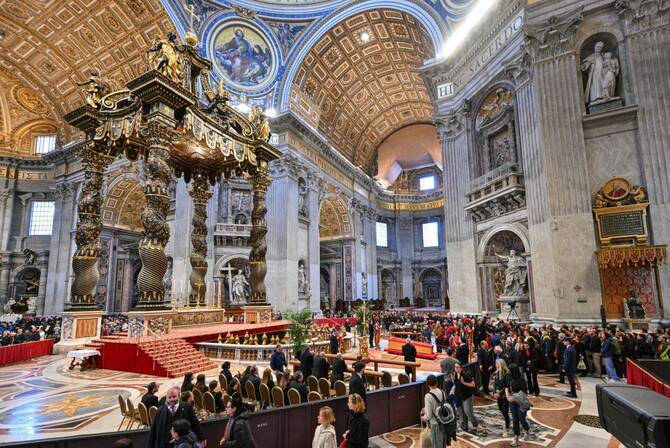VATICAN CITY: The Vatican was making final preparations Friday for Pope Francis’s funeral as the last of the huge crowds of mourners filed through St. Peter’s Basilica to view his open coffin.
Over 128,000 people have already paid their last respects to Francis, whose coffin will be closed at 8:00 p.m. (1800 GMT) in a ceremony attended by senior cardinals.
Many of the 50 heads of state and 10 monarchs attending Saturday’s ceremony in St. Peter’s Square, including US President Donald Trump and Ukrainian leader Volodymyr Zelensky, are expected to arrive later Friday in Rome.
Italian and Vatican authorities have placed the area around St. Peter’s under tight security with drones blocked, snipers on roofs and fighter jets on standby.
Further checkpoints will be activated on Friday night, police said.
Vast crowds of people on Friday morning packed Via della Conciliazione, the wide avenue leading to the Vatican, for the third and final day of the pope’s lying-in-state.
“Whatever happens, we have to get inside,” said Ian Delmonte, 35, from the Philippines.
“We love the pope, we feel blessed to see him a last (time),” added Michelle Alcaide, 35, also from the Philippines, as she queued.
For a second night in a row, the Vatican kept St. Peter’s open past the scheduled hours to accommodate the queues, only closing the doors between 2:30am (0030 GMT) and 5:40am Friday.
“Night is the most intimate moment, the Lord always manifests himself at night,” said Nicoletta Tomassetti, 60, who visited the Basilica in the very early hours of Friday morning.
“It was very emotional. In prayer, I asked the pope for some things and I know he will give them to me,” she said.
The Catholic Church’s first Latin American pope died on Monday aged 88, less than a month after spending weeks in hospital with severe pneumonia.
“It was like saying goodbye to a father” who “loved me and will continue to love me as and more than before,” Filipa Castronovo, 76, an Italian nun said after seeing the coffin on Friday.
The Argentine pontiff, who had long suffered failing health, defied doctors’ orders by appearing at Easter, the most important moment in the Catholic calendar.
It was his last public appearance.
Condolences have flooded in from around the world for the Jesuit, an energetic reformer who championed those on the fringes of society in his 12 years as head of the world’s 1.4 billion Catholics.
He used his last speech to rail against those who stir up “contempt... toward the vulnerable, the marginalized, and migrants.”
“It’s impressive to see all these people,” French cardinal Francois-Xavier Bustillo said of the queuing crowds, describing Francis as “a man of the people.”
“It’s a beautiful response, a beautiful embrace of his ministry, of his pontificate.”
At least 130 foreign delegations are expected at his funeral, including Argentina’s President Javier Milei and Britain’s Prince William.
A no-fly zone will be in force.
The pope’s body was dressed in his papal vestments – a red chasuble, white mitre and black shoes – and laid inside a simple wooden coffin.
On Thursday the Vatican banned people from taking photos inside the basilica, a move that eased the queue. It came after some mourners took selfies – deemed by many disrespectful – with the coffin.
Italy’s civil protection agency estimates that “several hundred thousand” people will descend on Rome on what was already set to be a busy weekend due to a public holiday on Friday.
After the funeral, Francis’s coffin will be driven at a walking pace to be buried at his favorite church, Rome’s papal basilica of Santa Maria Maggiore.
The hearse will pass down Rome’s Fori Imperiali – where the city’s ancient temples lie – and past the Colosseum, according to officials.
Big screens will be set up along the route on which to watch the ceremony, Interior Minister Matteo Piantedosi said.
Francis was a champion of underdogs, and a group of “poor and needy” will be at Santa Maria Maggiore to welcome the coffin, the Vatican said.
Francis will be interred in the ground, his simple tomb marked with just one word: Franciscus.
People will be able to visit the tomb from Sunday morning, as all eyes turn to the process of choosing Francis’s successor.
Cardinals from around the world have been returning to Rome for the funeral and the conclave, when a new pontiff will be elected.
In the absence of a pope, the cardinals have been meeting every day to agree the next steps, with another meeting held on Friday at 9:00 am (0700 GMT).
They have yet to announce a date for the conclave, but it must begin no fewer than 15 days and no more than 20 days after a pope’s death.
Only those under the age of 80 – currently some 135 cardinals – are eligible to vote.
Italian Cardinal Pietro Parolin, who was number two to Francis, is the favorite, according to British bookmakers William Hill.
They put him ahead of Filipino Luis Antonio Tagle, the Metropolitan Archbishop emeritus of Manila, followed by Ghana’s Cardinal Peter Turkson, and Matteo Zuppi, the Archbishop of Bologna.























